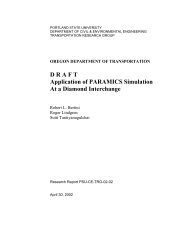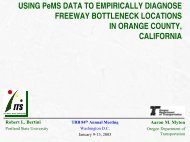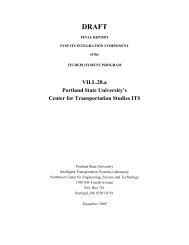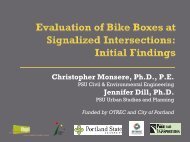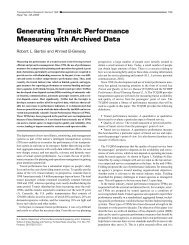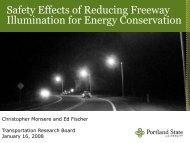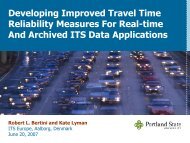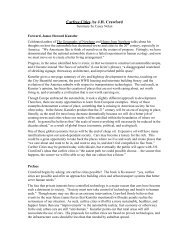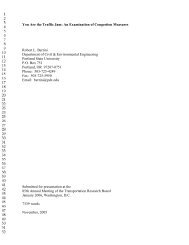Application of Paramics Simulation to a Diamond Interchange
Application of Paramics Simulation to a Diamond Interchange
Application of Paramics Simulation to a Diamond Interchange
Create successful ePaper yourself
Turn your PDF publications into a flip-book with our unique Google optimized e-Paper software.
<strong>Application</strong> <strong>of</strong> PARAMICS <strong>Simulation</strong> at a <strong>Diamond</strong> <strong>Interchange</strong> Page 12<br />
therefore 5.5% <strong>of</strong> the 87-vehicle deficit (5 vehicles) was added <strong>to</strong> the Zone 8 <strong>to</strong>tal making the<br />
<strong>to</strong>tal 591 vehicles as shown in Table 5. This process was repeated for each zonal attraction<br />
<strong>to</strong>tal creating a balance among the overall zonal production and attraction <strong>to</strong>tals as shown in<br />
Table 5.<br />
Finally, a balanced origin-destination matrix was created by an iterative proportional fitting<br />
(IPF) process. The IPF process adjusted the individual origin-destination cell values <strong>of</strong> the<br />
unbalanced matrix (Table 4) through a series <strong>of</strong> iterations until the overall zonal production<br />
and attraction <strong>to</strong>tals matched the adjusted actual turning movement count <strong>to</strong>tals determined in<br />
the previous step. For the first IPF iteration, each cell value was multiplied by an attractionbased<br />
balance fac<strong>to</strong>r that was created by dividing the unbalanced zonal attraction <strong>to</strong>tal by the<br />
actual zonal attraction <strong>to</strong>tal for that zone. For example, Zone 1 attracted 3994 vehicles in the<br />
unbalanced matrix, while the actual zonal attraction should be 4095. Therefore a balance<br />
fac<strong>to</strong>r <strong>of</strong> 4095/3994 or 1.025 was established. This process was repeated for each zone and<br />
new cell values were computed as the product <strong>of</strong> the balance fac<strong>to</strong>r and the original cell<br />
value. The matrix created by this initial iteration has, by design, perfectly matching zonal<br />
attraction <strong>to</strong>tals but will leave the zonal production <strong>to</strong>tals out <strong>of</strong> balance. The next iteration<br />
was therefore applied in a similar manner <strong>to</strong> zonal production <strong>to</strong>tals. The iterative steps that<br />
followed alternated balancing between attraction and production <strong>to</strong>tals until a maximum<br />
allowable difference was achieved. For this project, the maximum error was set at 2.0<br />
vehicles and thirty iterations were required <strong>to</strong> meet this goal. The balanced origin-destination<br />
matrix for PARAMICS modeling is shown in Table 4.<br />
Traffic Assignment Technique Selection<br />
The study area was a small network with only one route possible between each origin and<br />
destination, therefore the all-or-nothing technique was chosen.<br />
<strong>Simulation</strong> Run Execution<br />
Due <strong>to</strong> the s<strong>to</strong>chastic nature <strong>of</strong> simulation models, a relatively large number <strong>of</strong> runs must be<br />
conducted in order <strong>to</strong> estimate key measures <strong>of</strong> effectiveness with reasonable accuracy. Each<br />
PARAMICS model run with identical operation conditions but with different “random seed”<br />
numbers will produce different results.<br />
The “random seed” is required since driver behavior parameters are assigned <strong>to</strong> each<br />
simulated vehicle according <strong>to</strong> a predefined distribution. For example simulation run 1 with<br />
a random seed <strong>of</strong> 17 might assign <strong>to</strong> vehicle 1 an aggression parameter <strong>of</strong> 6, vehicle 2 with<br />
an aggression parameter <strong>of</strong> 4, etc. Each time a model run is initiated with a random seed <strong>of</strong><br />
17, each vehicle will be assigned the same behavior parameters as in the previous random<br />
seed 17 run and therefore all traffic operations and measures <strong>of</strong> effectiveness (MOEs) such as<br />
delay will be the same. Using the same random seed essentially reduces the model <strong>to</strong> a<br />
deterministic level. For better results, a random number table should be used when assigning<br />
random seed numbers.<br />
It is prudent <strong>to</strong> execute an initial number <strong>of</strong> simulation runs, and use the statistical estima<strong>to</strong>rs<br />
from this trial <strong>to</strong> compute the number <strong>of</strong> simulation runs required <strong>to</strong> meet a stated objective<br />
Portland State University Transportation Research Group 2002



